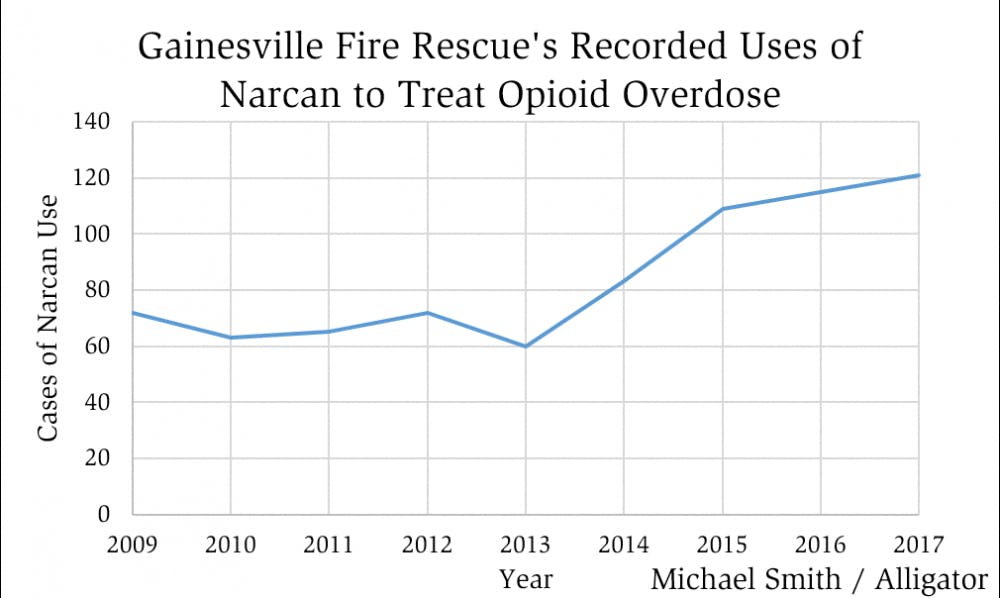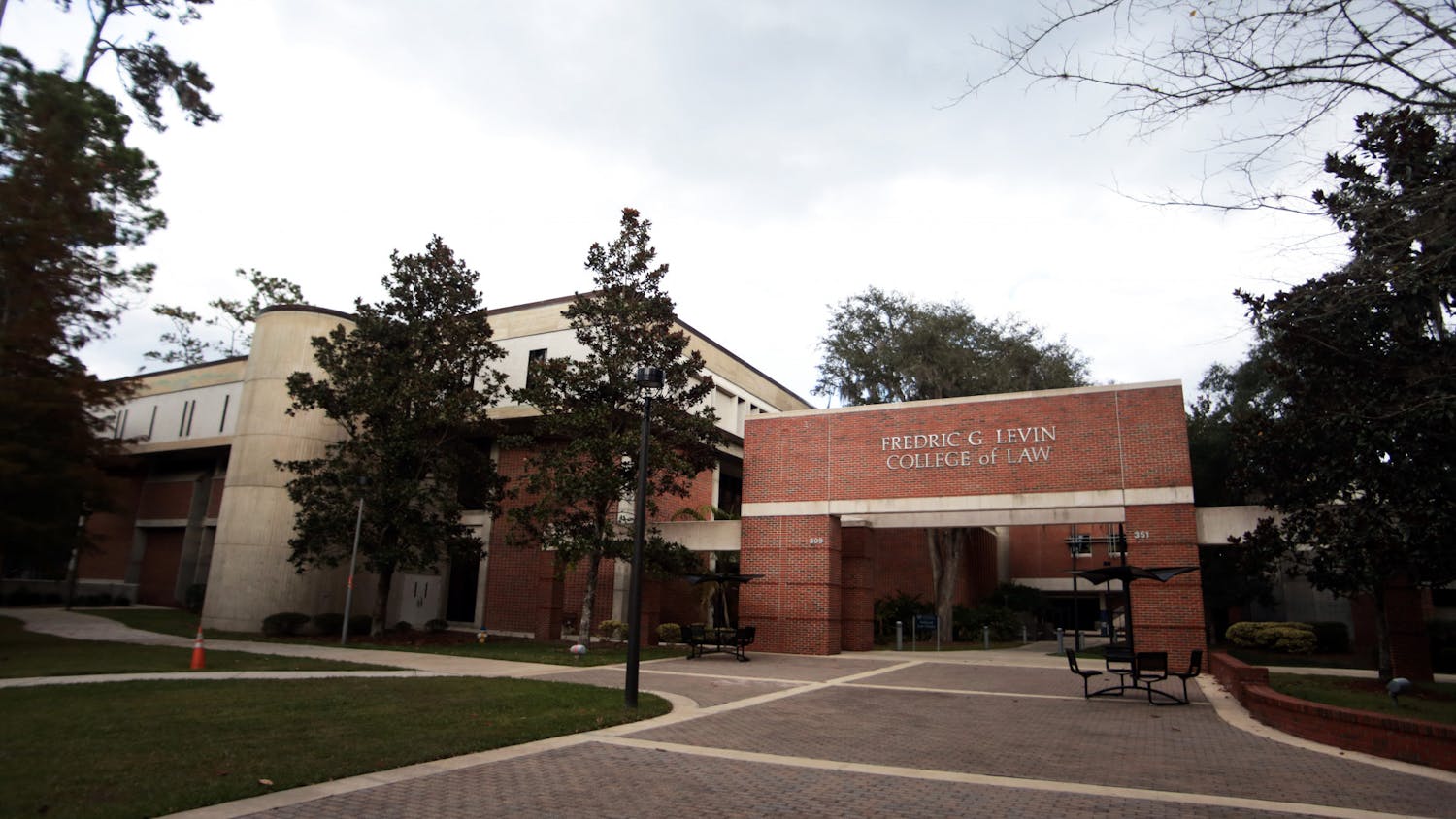For Clay County resident Kelli Crews, it all began on Florida State Road 21.
Five years ago, Crews’ son Clayton, then 6 years old, wanted something to drink as they rode down the street in their 2001 Nissan Pinta.
As Crews, 32, was about to turn across the intersection and pull into the Smoker’s Express station for a beverage, she was rear-ended by a woman in her 40s texting and driving in a black SUV, she said.
The accident caused two herniated discs for Crews, one in her upper back and one on the left side of her neck.
It was the first step toward her addiction. Although officials say opioid use has not increased in Alachua County as it has in other parts of the country, drugs still affect hundreds of people in the area, controlling every aspect of their lives.
At first, Crews was on fentanyl patches and trigger shots for the pain, she said. After her insurance stopped picking up the bill for her treatment, Crews’ doctor switched her to opioid painkiller Percocet.
What started as addressing her physical pain quickly turned into an addiction to the pill, she said.
“It numbed the feelings. It gave me energy, helped my depression,” Crews said. “It was like a mood-stabilizer all-in-one.”
Her body developed an immunity to the effects, and she found herself taking not two or three pills a day, but five or six.
In October of 2015, Crews dropped off Clayton with his grandmother Alice, 76, in Keystone Heights, Florida, and checked into Meridian Behavioral Healthcare in Gainesville for 90 days of detox. She started taking doses of Suboxone to stop the opioid craving.
Up until the summer of 2016, things were steady for Crews and Clayton. Crews moved to Kentucky to start a new life with her boyfriend.
In August, Crews’ brother, Scott, died in a car accident when his Ford Explorer malfunctioned and he lost control.
In September, she and her boyfriend broke up, and she moved back to Florida. Crews saw opioids as a solution when the stress of her brother dying and her broken relationship became too much.
“As soon as I got back to Florida, it was like the cycle started all over again,” she said. “I literally took a pill right after I got off the bus, I was just done with everything.”
Crews said she resorted to buying Percocet on the streets, $150 for about 40 to 50 pills a week. At her worst, she was taking 10 pills a day in addition to Xanax to sleep at night, she said.
That’s when she checked into Meridian the second time and did another 90-day session from November 2016 to February. She knew she wanted to escape from the pain inflicted during her drug abuse.
“There’s a period of time when I only saw darkness,” she said. “I wouldn’t get out of bed, I would just sleep and cry, sleep and cry.”
Alachua County has not seen the same level of opioid and narcotic crisis that’s swept the nation and the rest of Florida.
It’s worse in South Florida, though parts of North Central have seen a presence as well, said Gainesville Fire Rescue Chief Joseph Hillhouse.
In Duval County, medical examiners found fentanyl was the cause of about 40 deaths in 2015, while there were about five in Alachua County. Deaths per 100,000 people in Duval County were more than double that of Alachua County, according to UF’s Florida Drug-Related Outcomes Surveillance and Tracking System database.
Hillhouse said even though GFR has used Narcan, an anti-opiate medication, in emergency cases more often over the past decade, the trend matches a steady rise in all emergency calls.
Emergency medical personnel also use Narcan on residents who accidentally take too much of their prescribed medication or suffer a cardiac arrest, he said.
“If we put (opioids) on a pie chart of the emergencies we handle, it wouldn’t even have its own color on the chart,” Hillhouse said. “We do not have a rise in opioid use here in Alachua County.”
For Dr. Henry Young, a researcher and clinician with the UF Department of Emergency Medicine, the opioid issue is becoming more of a problem on the streets than over the counter. He said the primary opioid is manipulated and sold outside the doctor’s office.
“Now you’re noticing synthetic opioids and fentanyl medications from the street starting to overtake the epidemic,” he said.

Larry McGee, a drug counselor at the UF Health Florida Recovery Center, said he’s positive many UF students use opioids for experimentation rather than abuse.
McGee, who misused cocaine between 2002 and 2007, worries students are far more at risk nowadays because opioids are getting mixed with other substances.
“Maybe with one batch you were able to shoot up a $10 bag of heroin, then you go three days later and you buy a batch from someone else, and you’re dead,” he said. “You really just don’t know.”
Kelli Crews still has her worries.
She said she’s looking for work now and living with 11-year-old Clayton in Arbor House, St. Francis House’s permanent support housing for women and women with children.
Minimum wage life is taxing, she said, and she fears her Medicaid will not continue to cover the Suboxone pills she takes to abate the opioid temptations.
Despite the hardship, there’s a lot of good she has that keeps her spirits up — namely, her son.
When they’re not planning their next taco Tuesday dinner at home, Clayton’s favorite, or playing “Call of Duty” and “Destiny” together, they just hang out, mother and son.
“It gets better in time,” she said. “Now, I look forward.”
This is part one of a two-part series on locals with substance abuse disorders. Read the second part here.





